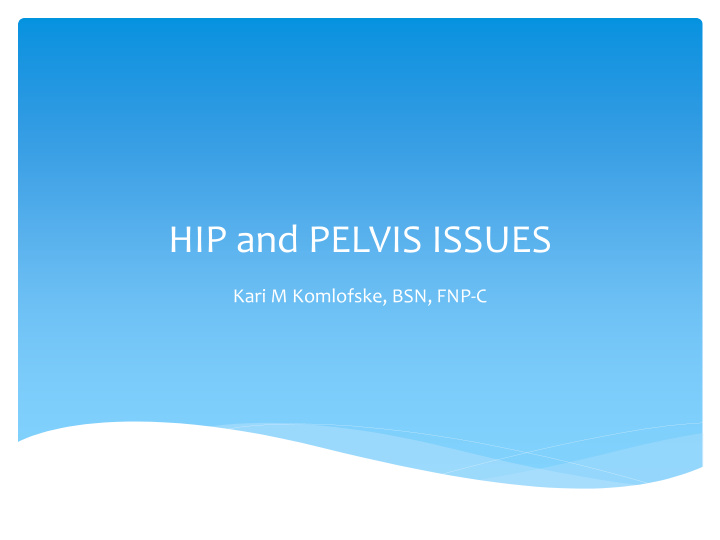



HIP and PELVIS ISSUES Kari M Komlofske, BSN, FNP-C
Objectives: ∗ To understand the anatomy of the pelvis and hip. ∗ To become familiar with common causes of hip pain. ∗ To gain understanding in regards to the diagnostics of common hip pain. ∗ Treatment options pertaining to hip pain.
Anatomy of the Pelvis • Bone Structure • Iliac crest • Ilium • Sacrum and Sacroiliac joint • Anterior/superior iliac spine • Coccyx • Ischium • Pubis – Pubic Symphysis
Pelvis and lateral (www.pelvis+anatomy.com)
Anatomy and MUSCLES
Anatomy and muscles of the Pelvis • Pectoris Major • Pectoris Minor • Piriformis Muscle • Sciatic Nerve • Inferior gluteal nerve and artery • Inferior pudendal nerve, artery, and vein • Nerve to quadratus Femoris • Nerve that supplies the Obturator Internus Muscle
Images for hip anatomy
Hip Anatomy – Muscles and Tendons ∗ Adductor muscles (inside thigh) ∗ Iliopsoas muscle (hip flexor muscle that attaches to the upper thigh bone ∗ Rectus femoris muscle (quadriceps muscle on front of your thigh) ∗ Ball and Socket joint
CAUSES OF HIP PAIN: • Muscle strain • Fracture • Tendonitis • Arthritis • Infection Pediatrics: • SCFE (Slipped Capital Femoral Epiphysis) • Avulsion of the Femoral Rectus • Congenital hip dysplasia • Septic arthritis
Pediatrics SCFE ∗ Slipped capital femoral epiphysis ∗ Condition happens in teens and pre- teens ∗ Causes: Obesity, increased pressure on growth plates, diabetes, thyroid disease, kidney disease ∗ Ball at the head of the femur “slips” off the neck of the bone posteriorly ∗ Surgical fixation indicated
Pediatrics continued… Avulsion of femoris rectus Sprinting exercises • Sudden intense pain • Inability to lift leg • Operative and non operative • Crutches for comfort • Time – usually 6-10 weeks recovery •
Pediatrics: Congenital hip dysplasia ∗ Hip socket doesn’t full cover the femoral head ∗ Birth to 1 year – sooner it is diagnosed (prior to 6 months) better non op treatment ∗ Often treated in Pavlik device ∗ Can lead to chronic issues if untreated or undiagnosed.
Adult and Child Septic arthritis HIP ∗ Causes can be native joint, traumatic Adult/Child injury, prosthetic joint, previous ∗ Infection of the hip joint fluid surgery (synovium) and joint tissues. ∗ Underlying cause ∗ Pt is often septic or ill with fever, +/- ∗ Infections may include: blood cultures - Staphylcocci – skin ∗ Diagnostic is joint fluid aspiration- IR - Haemophilus influenzae ∗ Treatment formal irrigation and - Gram-negative Bacilli debridement with IV antibiotics (E.Coli) - Streptococci
ADULT Muscle Strain/Hip flexor can include: ∗ Sudden, sharp pain in the hip or pelvis after trauma to the area. ∗ A cramping or clenching sensation in the muscles of the upper leg area. ∗ The upper leg feeling tender and sore. ∗ Loss of strength in the front of the groin along with a tugging sensation. ∗ Muscle spasms in the hip or thighs Tendonitis: ∗ The iliopsoas muscle flexes your hip, bends your trunk towards your thigh and rotates your thigh bone. This tendon can get irritated from overuse, muscle weakness and muscle tightness, resulting in tenderness and pain.
Treatment 1. REST 2. Muscle strain and tendonitis can take up to 6 weeks depending on the severity 3. Patience 4.Begin with stretching exercises around week 2 when pain is improved 5. Slowly increase activity as tolerated 6.Around six weeks increase strength training and endurance
FRACTURE ∗ A fracture is a break. It is broken (no such thing as a little broken). ∗ If a patient is having pain that isn’t getting better further investigation needs to happen – possibly a CT scan ∗ Pelvis fractures – generally non operative in older people -- rami fracture – non op, WBAT, advance activities as tolerated --Acetabulum fracture – need orthopedics – generally non WB x 10 weeks; surgical or non surgical ∗ HIP – Almost always surgical -- Femoral neck – non displaced percutaneous pinning --displaced – hemiarthroplasty (1/2 hip replacement) -- Intertrochanteric/subtrochanteric: intramedullary rod -- Femur – shaft: ORIF -- Distal femur: Retrograde nail
Just a few Facts… Hip Fractures – 20 percent mortality age over 80 years • 1:5 will die within one year of fracture • Return to baseline is goal • Fixation within 24 hours is goal • Peripheral nerve block pre-operatively helps decrease narcotic use • High risk post operative delirium
Arthritis of Hip ∗ Arthritis is the most common cause of hip pain leading to replacement ∗ TREATMENT - NSAIDS - Injections - Activity modifications - Physical therapy ∗ Treatment for arthritis is based on PAIN. It is based on pain that is daily and interferes with the patient's ADL’s. ∗ Replacement is an elective surgery anterior vs posterior approach
INJECTIONS Consider injection to manage chronic pain • issues Kenalog 40 mg/ml (one ml) Lidocaine 1% 4 • ml Marcaine 0.25% 4ml total of 8-9 ml will take a full week for the steroid (7 days) up to three to four times per year. End stage arthritis as much as they want • (Injection limit three per site)
REFERENCES ∗ Bates' Guide to Physical Examination and History Taking, 9th ed. Philadelphia, PA: Lippincott Williams & Wilkins ∗ Netter, Frank H. M.D. (2006). Atlas of Human Anatomy, 4 th ed. Philadelphia, PA: Elsevier Health Sciences. ∗ Sarwark, John, F. (2010). Essentials of Musculoskeletal Care 4. Rosemont, IL: American Academy of Orthopaedic Surgeons. ∗ Stoller, David, W. (2008). Stoller's Atlas of Orthopaedics and Sports Medicine. Baltimore, MD: Lippincott Williams & Wilkins, a Wolters Kluwer business. Bickley, Lynn, S. (2007). ∗ www.pelvis+anatomy.com; August 2018. ∗ www.wheelessonline.com/; August-September 2018.
Recommend
More recommend